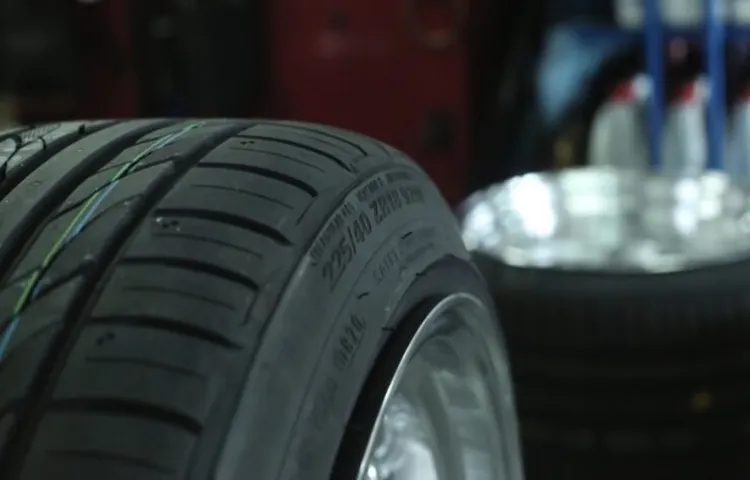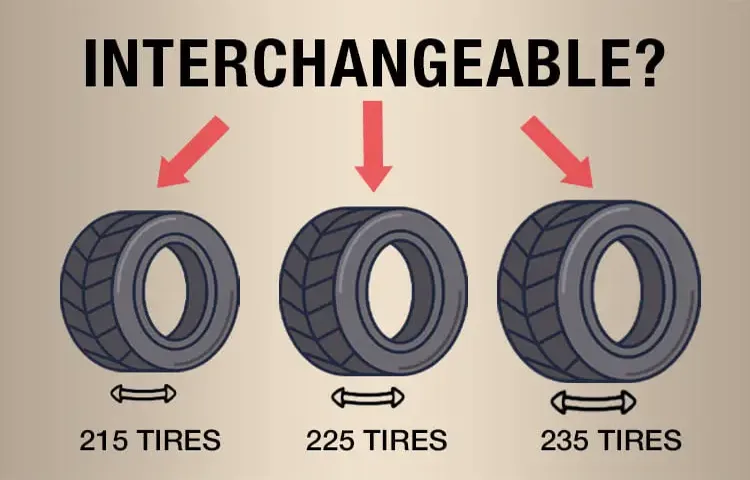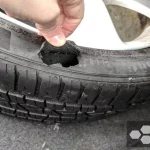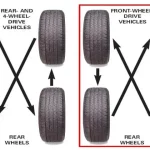If you’re looking to upgrade your vehicle’s tires, you may be wondering about the difference between a 225 width and a 235 width. While they may seem similar, there are actually some significant distinctions between the two. Understanding these differences can help you make an informed decision about which tires are right for your vehicle.
The primary difference between a 225 and 235 tire is the width. A 225 tire is 225 millimeters wide, while a 235 tire is 235 millimeters wide. This may not seem like a big deal, but it can actually have a significant impact on your vehicle’s performance.
Wider tires generally provide better stability and grip, especially in corners and on wet surfaces. However, they also tend to have a higher rolling resistance, which can decrease fuel efficiency. Narrower tires, on the other hand, may provide better fuel efficiency but may not offer the same level of stability and grip.
Ultimately, the choice between a 225 and 235 tire will depend on a variety of factors, including your driving style, the type of vehicle you have, and the weather and road conditions in your area. By carefully considering these factors and doing your research, you can find the perfect set of tires to maximize your vehicle’s performance and safety.
Table of Contents
Understanding Tire Size
If you’re looking at tire options for your vehicle, you might be wondering what the difference is between a 225 and 235 tire. This number refers to the tire’s width in millimeters, with the first number denoting the width of the tire’s tread. Essentially, a 235 tire is slightly wider than a 225 tire, which can result in better handling and traction on the road.
However, there are other factors that come into play when selecting the right tire for your vehicle, such as the aspect ratio and diameter. It’s important to consult with a professional or refer to your vehicle’s manual to ensure that you’re choosing the right tire size for optimal performance and safety.
Breaking down the numbers
When it comes to understanding tire size, things can get a bit confusing. The numbers on the side of your tire contain important information about its size and capabilities. The first number represents the width of the tire in millimeters, while the second number indicates the aspect ratio, or the ratio of the tire’s height to its width.
The letter that follows denotes the tire’s construction type, with “R” indicating a radial tire. The next number specifies the diameter of the wheel that the tire is meant to fit on. So, for example, a tire with the numbers 215/60R16 would be 215 millimeters wide, have an aspect ratio of 60, be a radial tire, and fit on a 16-inch wheel.
Understanding tire size is important for ensuring that you choose the right tires for your vehicle, as well as for maintaining optimal performance and safety on the road.

How tire size affects performance
Tire Size Choosing the right tire size is crucial as it can heavily impact the performance of your vehicle. The size of your tire affects various aspects of its performance, including traction, handling, comfort, and fuel efficiency. When selecting the optimum tire size, it’s important to ensure a proper fit with your vehicle’s wheels and suspension system.
A larger tire size will increase the overall diameter of the wheel, which can enhance traction, handling, and fuel efficiency, and equally can decrease your braking distance and acceleration. On the other hand, smaller tire size tends to offer more comfort, but typically the performance of the car is reduced. In summary, choosing the right tire size can be determined based on various factors, including the intended use of the vehicle, driving environment, and personal preference.
225 Tires: Pros and Cons
When it comes to choosing the right tire size for your vehicle, it can be overwhelming to decipher all the differences. One of the most common questions is the difference between a 225 and 235 tire. The main difference between the two is width.
The 225 is narrower than the 235, and therefore, it offers a little bit better fuel economy. But, the bigger 235 tire provides a little more stability and is ideal for larger SUVs or trucks. However, the downside with using a 235 tire is that it may result in increased road noise, reduced comfort, and slightly worse fuel efficiency compared to a 225 tire.
Ultimately, it comes down to your personal preference, needs, and driving habits. If you want better handling and performance, go for the larger 235 tire. But, if you are more concerned about fuel economy and efficiency, then the 225 is the better option.
Advantages of 225 tires
One of the advantages of 225 tires is that they offer better stability and handling on the road. Compared to narrower tires, 225 tires have a wider surface area that provides better traction and grip. This is especially useful during wet or slippery conditions as they can help prevent skidding or hydroplaning.
Another advantage is that they offer improved comfort and a smoother ride. This is because they have a larger air volume, which allows for better shock absorption and reduces road noise. Additionally, 225 tires can improve the overall appearance of your vehicle, giving it a sportier and more aggressive look.
However, there are also some drawbacks to consider. These tires can be more expensive than narrower options, and they may also decrease fuel efficiency due to increased rolling resistance. It’s essential to weigh both the pros and cons before choosing 225 tires for your vehicle and consider your specific driving needs and environment.
Disadvantages of 225 tires
While 225 tires offer improved handling and traction compared to smaller tires, they do have some disadvantages. One of the main drawbacks is their reduced fuel efficiency due to increased rolling resistance. The wider the tire, the more rolling resistance it will have, resulting in lower fuel economy.
This can be a significant issue for those who drive frequently or travel long distances. Additionally, 225 tires tend to be more expensive than smaller tires, which can be a concern for those on a budget. Furthermore, wider tires may not be as effective in snowy or wet conditions, as they have a tendency to float on top of the surface instead of gripping it.
Ultimately, while 225 tires offer many benefits, it is important to consider their drawbacks before making a final decision.
235 Tires: Pros and Cons
Have you ever wondered what the difference is between a 225 and 235 tire? Well, the main difference lies in the width of the tire. A 235 tire is wider than a 225 tire, which means it provides more stability and grip on the road. This makes it a great choice for high-performance vehicles or for those who frequently drive in challenging road conditions.
However, with the added width comes a few downsides. For one, a wider tire can reduce fuel efficiency. Additionally, a 235 tire can sometimes rub against the wheel well or suspension system, causing unnecessary wear and tear.
That being said, the decision to go with a 225 or 235 tire ultimately depends on your specific driving needs and preferences. Do you value stability and added grip over fuel efficiency? If so, a 235 tire may be the right choice for you.
Advantages of 235 tires
Are you considering upgrading to 235 tires but not sure if they’re worth it? Let’s take a look at some pros and cons of using these tire sizes. One advantage of using 235 tires is their improved handling and stability on the road. With a wider tread, these tires offer better grip, making it easier to handle your vehicle while driving, especially in wet or snowy conditions.
Additionally, they provide better traction and can endure more weight, making them perfect for larger vehicles like trucks and SUVs. Another benefit of 235 tires is their improved aesthetic appeal. They give your vehicle a more aggressive and sporty look, which is sure to turn some heads on the road.
However, one potential disadvantage of using these tires is their increased fuel consumption since they cause more drag and resistance. Additionally, they can be a bit more expensive than smaller tire sizes. Overall, the decision to upgrade to 235 tires depends on your specific needs and driving style, but if you’re looking for improved handling and a sporty look, they may be worth the investment.
Disadvantages of 235 tires
When it comes to tires, size definitely matters. While 235 tires are a popular choice among many vehicle owners, there are some disadvantages to using them. One major drawback is their decreased handling ability.
Since these tires are wider, they tend to have less traction and can struggle in wet or icy conditions. Additionally, 235 tires may have a negative impact on fuel economy, since they require more energy to move. This can lead to higher gas costs over time.
Despite their downsides, however, there are still numerous benefits to using 235 tires, such as improved cornering and a smoother ride. Ultimately, it’s up to the driver to weigh the pros and cons and decide whether the tradeoff is worth it.
Which one is right for you?
If you’re wondering what the difference is between a 225 and 235 tire, there are a few factors to consider. The first and most obvious difference is the size. A 225 tire is narrower than a 235 tire, which means it will fit better on narrower wheels.
If you have a sports car or another vehicle with narrow tires and wheels, then a 225 tire may be the better choice for you. On the other hand, if you have a truck or SUV with wider wheels, then you may want to go with a 235 tire for better traction and stability. Additionally, a wider tire can give your vehicle a more aggressive look, which may be important if you’re going for a certain aesthetic.
Ultimately, the choice between a 225 and 235 tire depends on your specific needs and preferences.
Factors to consider when choosing a tire size
When it comes to choosing the right tire size for your vehicle, there are a few factors you should consider. Firstly, think about the type of driving you will be doing. If you mostly drive on the highway, a narrower tire may be better for fuel efficiency and handling at higher speeds.
However, if you frequently drive on rough roads or in inclement weather, a wider tire with deeper treads can provide better traction and stability. Additionally, make sure to check your vehicle’s recommended tire size, as switching to a drastically different size can affect your car’s performance and safety. Ultimately, the best tire size for you will depend on your individual driving needs and preferences.
Remember to consult with a professional if you are unsure about which tire size to choose.
Conclusion
In the world of tires, the difference between a 225 and 235 may seem like small potatoes, but don’t be fooled – it can be a game changer. The 235 might offer a wider stance and a bit more grip, but the 225 might just offer better fuel efficiency and handling on the road. So ultimately, the choice between a 225 and 235 comes down to your priorities and what you value most in your driving experience.
Just remember, even though they may seem similar, these two tire sizes are like apples and oranges – both delicious, but miles apart in taste.”
FAQs
What is the meaning of the numbers 225 and 235 in tire sizes?
The numbers refer to the width of the tire in millimeters. A 225 tire is 225mm wide and a 235 tire is 235mm wide.
Can I put a 235 tire on a rim intended for a 225 tire?
It depends on the width of the rim. A 235 tire requires a wider rim than a 225 tire, so if the rim is not wide enough, it is not recommended to use it with a 235 tire.
Will a 235 tire provide better traction than a 225 tire?
Not necessarily. Traction depends on several factors, including the tread pattern and the type of tire. The width of the tire alone does not determine traction.
Is a 235 tire more expensive than a 225 tire?
It depends on the brand and model of the tire. Generally, wider tires tend to be more expensive, but other factors like the tire’s construction and features can also affect the price.
Can I switch from a 225 tire to a 235 tire without affecting my car’s performance?
Switching to a wider tire can affect your car’s handling and performance. It is recommended to consult a professional before making any changes to your tires.
Is a 225 or 235 tire better for fuel efficiency?
The width of the tire does not necessarily affect fuel efficiency. However, wider tires can create more rolling resistance, which can decrease efficiency. It is best to choose a tire that is recommended for your vehicle and driving habits.
Will a 235 tire affect my car’s speedometer reading compared to a 225 tire?
Yes, switching to a wider tire can affect your car’s speedometer reading and accuracy. It is recommended to have your speedometer recalibrated after changing tire sizes.



